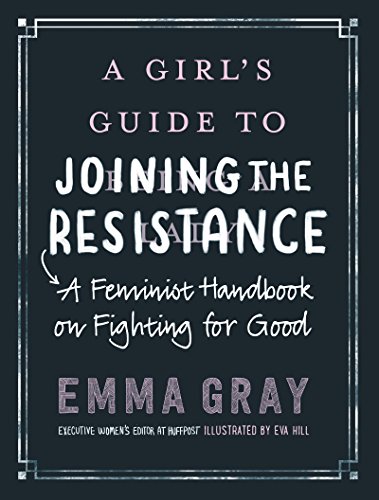|
|
|
See another section in Articles & Speeches |
|
|
A Girl's Guide to Joining the Resistance: A Feminist Handbook on Fighting for Good
by Emma Gray
 This is an excerpt from A Girl's Guide to Joining the Resistance: A Feminist Handbook on Fighting for Good by Emma Gray.
Dear White Ladies:
A NOTE ON INTERSECTIONALITY
“My feminism will be intersectional or it will be bullshit.”
— FLAVIA DZODAN, TIGER BEATDOWN
The first time I heard the term intersectionality, I was in college. Surprise, surprise, the lady who ended up writing about women’s issues professionally spent four years discussing the merits of
Judith Butler and bell hooks. Shocking, right? But I know that I felt relieved to finally have a word to describe a concept that felt totally integral to everything I was learning (and living).
At its core, intersectionality is simple, almost obvious: groups of people are not monolithic—our identities overlap and compound in myriad ways. Therefore, when you talk about “women” or “the LGBTQ community,” you are talking about groups of people who share some com- mon experiences but whose lives vary in many other ways. The key is that these differences impact the way that individuals experience the world and therefore the way they experience whatever particular oppression an activist or organizer is trying to combat. If you are blind to—or willfully ignore—these differences, it becomes impossible to create lasting and meaningful solutions; if a solution addresses only a part of the problem, it’s not actually a solution at all—it’s a Band-Aid, reserved for only a few.
As gun-safety activist Lucy McBath put it, “You cannot focus on one issue without the intersectionality of all of the issues. It’s like you have a wheel and every issue is a spoke that ties into that wheel. Until we’re able to eradicate or work on all of these kinds of issues, we’ll never solve one issue. Because they’re all intricately connected.”
You might be thinking, “Well . . . duh.” And you’d be right! But putting intersectionality into practice is when things get tough. There’s not a social movement in history that hasn’t had issues with actually advocating for the entirety of the group it purports to be fighting for. Look no further than the suffragettes, many of whom chose to prioritize middle-class white women’s rights at the expense of women of color.
This problematic idea of educated middle-class white women as a universal stand-in for “women” continues to be an issue today. But today we are, at the very least, better equipped to confront it.
In my experience, most young women already understand these concepts—or latch onto them quickly once introduced to them. They under- stand intersectionality and white feminism, which is more than I can say for my own teenage self. Young women today know that feminism without intersectionality is no feminism at all.
Intersectionality theory was first named by law professor Kimberlé Crenshaw in the 1980s to address a specific issue: the compounding and over- lapping discrimination that women of color face in the workforce, and the failure of anti-discrimination laws—which looked at race and gender discrimination as completely separate entities rather than overlapping and compounding—to address that reality.
In the more general sense, intersectionality is a lens and analytical tool through which to view the world holistically. It points to the varying and complex ways that different facets of our identities intersect, informing the oppression that we experience. A black woman is not going to experience sexism in the exact same way as a white woman. A butch, queer, Latina woman is not going to experience homophobia the same way a bisexual, femme, Asian woman does. And all of the corresponding isms and phobias ultimately serve the same common purpose: to keep most of us divided and down in order to lift up a vaunted few (a.k.a., able-bodied, affluent, straight, cisgender white men). And it’s historically been a reluctance—primarily by affluent, straight, cisgender white women—to acknowledge these differences and intersections that has created the erasure of many women in feminist spaces.
This is a reality that self-described “proud, unapologetic, queer, black, transgender woman from Augusta, Georgia” Raquel Willis spoke about at the Women’s March, nodding to the iconic “Ain’t I a Woman” speech women’s rights and antislavery activist Sojourner Truth gave at the 1851 Women’s Convention in Ohio.
“I want to stress the importance of us being intentional about inclusion,” Willis said to the thousands gathered in DC. “Black women, women of color, queer women, trans women, disabled women, Muslim women, and so many others are still asking many of y’all, ‘Ain’t I a woman?’ So as we commit to build this movement of resistance and liberation, no one can be an afterthought.”
This idea has been key to the broadening of the feminist movement, especially in pushing white feminists to consider the many ways that race and gender interact. Because white feminism (that is, feminism by and for white women only, which doesn’t consider the nuanced experiences that women have depending on their varying identities) isn’t true feminism.
As a white woman, I get an education every day from women of color, and my understanding of how best to practice intersectionality in my daily life—and especially in my work—continues to grow. I asked many of the women I interviewed for this book to tell me what intersectionality meant to them, and how it played out in the work they do. I learned a lot by listening to them—listening is key—and I wanted to share that wisdom with you, dear readers.
Here’s what intersectionality means to a few active, influential women:
Deja Foxx, High School Student and Reproductive Justice Advocate
“Intersectionality is really what activism is all about. Our identities and experiences are unique to us, and working to appreciate that in the methods we use to resist oppression makes us more united. To appreciate the intersections of an issue like reproductive justice is to look at the larger machine of oppression and the ways it affects each of us in different ways. But what is most important about this understanding is meeting the experiences of others with compassion.”
Flavia Dzodan, Writer
“[Intersectionality is] a lens through which I look at all political, and social, and cultural issues. I try—I say try, because we all have blind spots, but what I try to do is look at everything from that intersectional lens. To me, it’s a tool that you apply trying to understand any given situation. It’s an exercise of thinking of the world outside yourself, outside of your own lived reality. I’m specifically thinking here of young white women, because you [don’t need] to explain this to young women of color, who have already lived through this. For young white women, it’s a matter of thinking outside their own subjectivity.”
Amanda Gorman, Activist and Youth Poet Laureate of the United States
“Intersectionality is kind of a buzzword, and sometimes if you say a word too much, you forget its meaning. But intersectionality for me, at least in the feminism movement, is a willingness to interrogate [the ways] in which our experiences converge and diverge. And also the commitment to unite for women’s rights with that awareness. Young women of today have excavated something that is quite significant and builds upon the work of previous feminists. We’re more open to interrogating the intersections of race, gender, class, ability, immigration, et cetera. And that type of critical thinking, which looks at a woman’s identity as a mosaic, rather than a one-color painting, I think that is the power behind women and girls of today.”
Alicia Garza, Cofounder of Black Lives Matter Network and Special Projects Director at the National Domestic Workers Alliance
“Intersectionality looks at the ways in which race, class, gender, and other social positions impact our lived experiences. I see a lot of people talking about intersectionality these days, but they haven’t taken the time to understand what it means and how it shows up in our lives. Intersectionality isn’t diversity—it is fundamentally about relationships of power and how we embody those relationships, and the impacts that power has on our lives and on the lives of others. I encourage everyone to actually read Dr. Kimberlé Crenshaw’s essay on intersectionality. We owe it to ourselves to get it right and not cut corners.”
For more information: A Girl's Guide to Joining the Resistance — A Feminist Handbook on Fighting for Good by Emma Gray. Published by Harpers Collins.
 Emma Gray is the Executive Women's Editor at HuffPost. She is also the co-host of the "Bachelor"-themed podcast, "Here To Make Friends," which was named a "must-listen" by The Daily Dot, and has appeared as an expert on the Today Show, Good Morning America, The Insider, and Entertainment Tonight. Emma is an alum of McGill University in Montreal, which is probably why she has such a soft spot for poutine and St. Viateur bagels. Emma Gray is the Executive Women's Editor at HuffPost. She is also the co-host of the "Bachelor"-themed podcast, "Here To Make Friends," which was named a "must-listen" by The Daily Dot, and has appeared as an expert on the Today Show, Good Morning America, The Insider, and Entertainment Tonight. Emma is an alum of McGill University in Montreal, which is probably why she has such a soft spot for poutine and St. Viateur bagels.
|